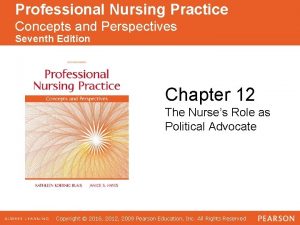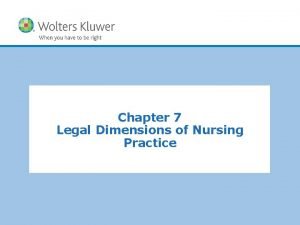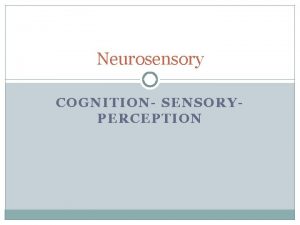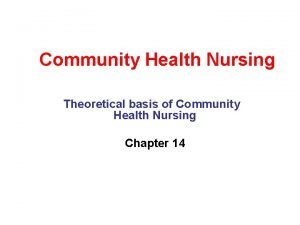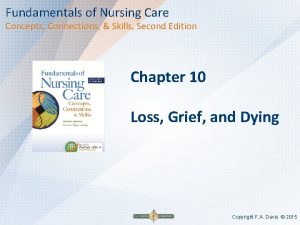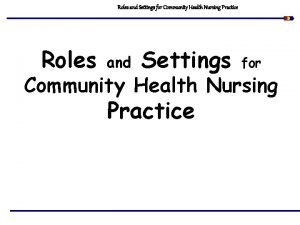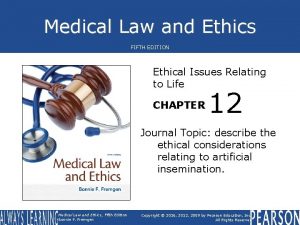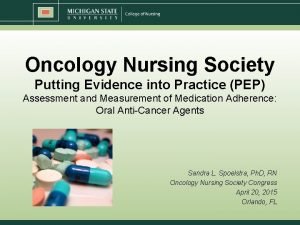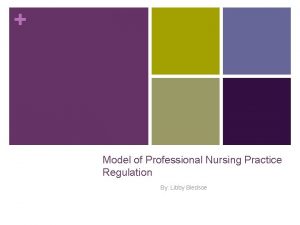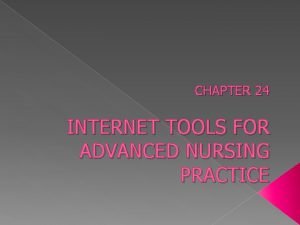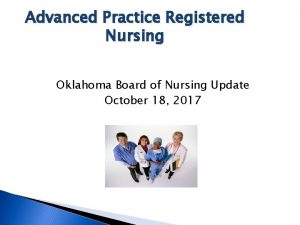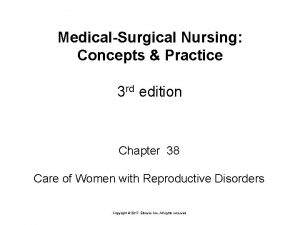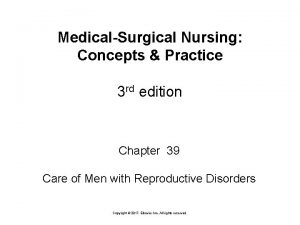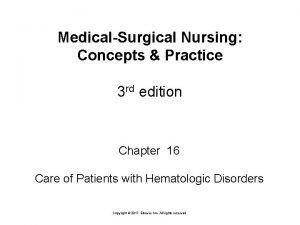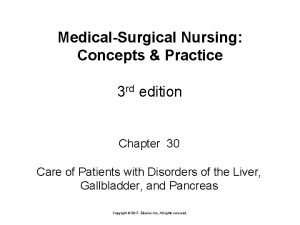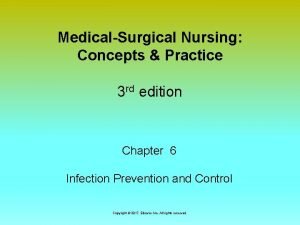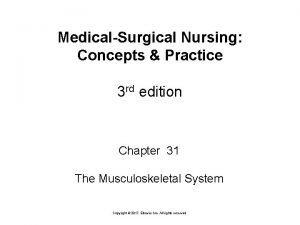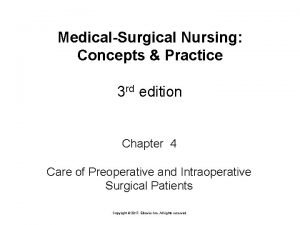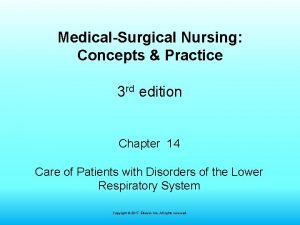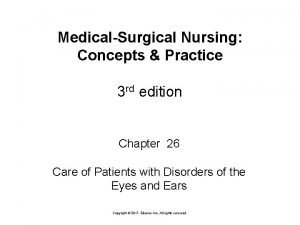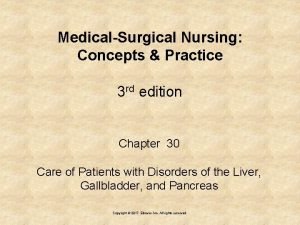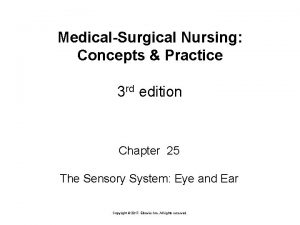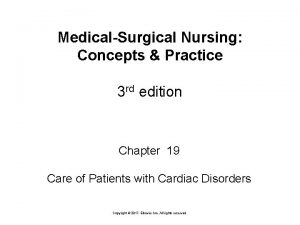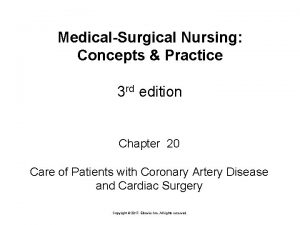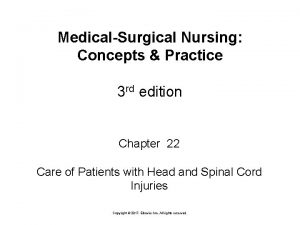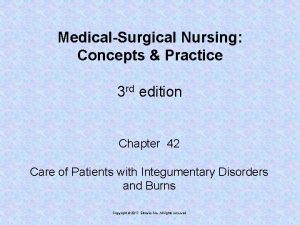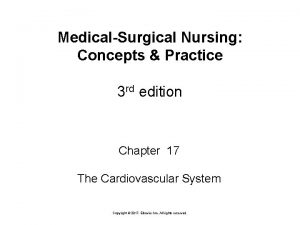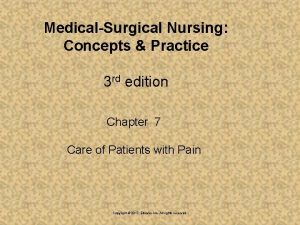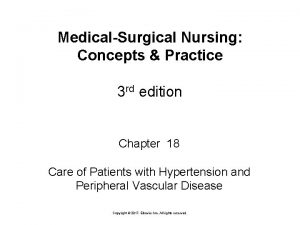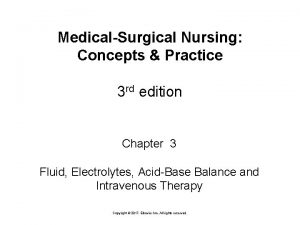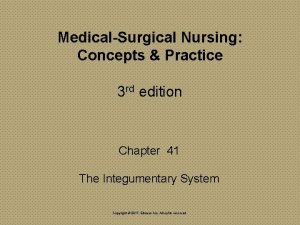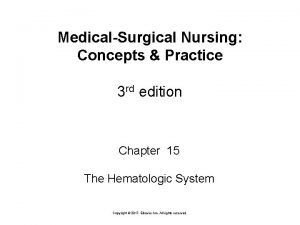MedicalSurgical Nursing Concepts Practice 3 rd edition Chapter































- Slides: 31

Medical-Surgical Nursing: Concepts & Practice 3 rd edition Chapter 41 The Integumentary System Copyright © 2017, Elsevier Inc. All rights reserved.

Theory Objectives Describe the structure and functions of the skin. Compare and contrast the various causes of integumentary disorders. Analyze important factors in the prevention of skin disease. Plan specific measures to prevent skin tears. Copyright © 2017, Elsevier Inc. All rights reserved. 2

Theory Objectives (Cont. ) Interpret laboratory and diagnostic test results for skin disorders. State nursing responsibilities in the diagnosis of skin disorders. Write outcome objectives for a patient with a problem of altered skin integrity. Copyright © 2017, Elsevier Inc. All rights reserved. 3

Clinical Practice Objectives Teach three patients to perform a selfassessment of the skin. Analyze the changes that have occurred with aging that affect the skin barrier for one of your older adult patients. Perform a focused integumentary assessment on a patient. Copyright © 2017, Elsevier Inc. All rights reserved. 4

Clinical Practice Objectives (Cont. ) Provide skin care for an older adult with dry skin. Implement a teaching plan appropriate for adolescents and young adults for the prevention of skin cancer. Copyright © 2017, Elsevier Inc. All rights reserved. 5

Integumentary System Skin Structure – 1. epidermis – top layer – thin tissue – no blood vessels- cell growth occurs at the bottom of the epidermis and pushes cells up to the surface. Bottom layer contains melanocytes – give color to the skin. 2. dermis – inner layer – contains blood vessels and nerves, base of hair follicles, glands and nails. Fibroblasts are in this layer to produce new cells to heal the skin. 3. subcutaneous tissue – skin is attached to underlying structures Copyright © 2017, Elsevier Inc. All rights reserved. 6

Functions of the Skin Protective covering – keratin in the skin makes it waterproof Barrier to bacteria Protects underlying tissues from injury Regulates body temperature With sunlight, converts rays to Vitamin D Nerves receptors conveys touch (heat, cold) 7

Effects of Aging on the Skin Elastic fibers adipose tissue decrease – skin will wrinkle and sag Collagen fibers decrease – skin becomes fragile Skin thinner, more transparent Decrease sebaceous gland activity reduced temp control – Decrease melanocytes – increase in sunburn, skin cancer Susceptible to fungal infections – thick nails. 8

9

Audience Response Question 1 Which physiologic change(s) associated with aging predispose(s) older adults to skin breakdown? (Select all that apply. ) 1. 2. 3. 4. 5. Decreased melanocytes Loss of collagen Increased elastic fibers Decreased adipose tissues Reduced sebaceous gland activity Copyright © 2017, Elsevier Inc. All rights reserved. 10

Integumentary System – Causes for Disorders of the Skin Pathology in the skin itself – bacteria, virus Manifestations of systemic disease – immune/inflammatory disorder (i. e: allergies), neoplastic disorder, metabolic disorder, endocrine disorder or nutritional disorder 11

Prevention Factors Hygiene Diet – dehydration causes loss of skin turgor Age- old & sweat glands become less active, less elasticity Environment – exposure to chemicals, cold temp, water immersion, exposure to sun, occupational hazards. 12

Audience Response Question 4 The nurse reminds teenagers regarding the importance of protecting their skin from ultraviolet rays by (Select all that apply. ) 1. 2. 3. 4. 5. using a sunscreen with a skin protective factor (SPF) of at least 15. applying sunscreen thinly. wearing light, loose-fitting clothing. gauging exposure while in the sun. wearing sunglasses and a hat. Copyright © 2017, Elsevier Inc. All rights reserved. 13

Good nursing care – Skin integrity See Box 41 -1 page 960 And Box 41 -2 page 960 Causes can be careless handling, friction Skin tears are classified Payne Martin classification system Ø Ø Ø Category I – skin tear without tissue loss Category II – skin tear with partial tissue loss Category III – skin tear with complete tissue loss epidermal flap is missing 14

Risk Factors for Skin Tears Dry skin with dehydration Areas of ecchymoses Presence of friction, shearing, or pressure from bed or chair Impaired sensory perception Impaired mobility Taking multiple medications Prolonged use of corticosteroids Copyright © 2017, Elsevier Inc. All rights reserved. 15

Risk Factors for Skin Tears (Cont. ) Presence of renal disease, congestive heart failure, or stroke impairment Incorrect removal of adhesive dressings Rough handling when being bathed, dressed, transferred, or repositioned Copyright © 2017, Elsevier Inc. All rights reserved. 16

Skin Tear Protocol Continuously cleanse the wound. Conform to the wound. Absorb exudates. Keep the wound bed moist and reduce pain and discomfort. Copyright © 2017, Elsevier Inc. All rights reserved. 17

Audience Response Question 3 The nurse launching an information campaign to prevent skin tears among the residents in a longterm care facility should include (Select all that apply. ) 1. 2. 3. 4. 5. encouraging wearing long sleeves and pants. providing adequate lighting. using germicidal soap every day on extremities. supporting dangling arms and legs with pillows or blankets. removing tape and dressings with extreme caution. Copyright © 2017, Elsevier Inc. All rights reserved. 18

Diagnostic Test and Procedures Biopsy – identify benign or malignant lesions or cause for infection – bacterial/fungal Culture and sensitivity test – sample exudate to help identify best antibiotic for treatment Special light inspection – Cold light/Wood Diascopy – glass pressed on skin Skin patch testing 19

Assessment (Data Collection) Focused assessment on the skin – see page 962 Physical assessment – done under good lighting be aware elderly have common skin conditions like keratosis, keloids or senile purpura. Pictures following 3 slides Note any lesions with metric measurements – see Table 41 -1 Types of Skin Lesions Copyright © 2017, Elsevier Inc. All rights reserved. 20

Seborrheic Keratoses 21

Keloid Scar Copyright © 2017, Elsevier Inc. All rights reserved. 22

Senile Purpura 23

Types of Skin Lesions Table 41 -1 Macule Papule Vesicle Plaque Wheal Pustule Copyright © 2017, Elsevier Inc. All rights reserved. 24

Patient Teaching for Skin Self-Exam Darkening or spreading of color or increasing unevenness of color Increase in size or diameter Change in shape (Has the lesion become elevated, or have its formerly regular edges become irregular? ) Redness or swelling of surrounding skin, or any other noticeable change around the lesion Copyright © 2017, Elsevier Inc. All rights reserved. 25

Patient Teaching (Cont. ) Itching, tenderness, or other change in sensation Crusting, scaling, oozing, ulceration, or other change in the surface of the lesion When assessing for melanoma, check for the ABCDs: A = asymmetrical, B = irregular border, C = color, D = diameter change greater than 1/4 inch Copyright © 2017, Elsevier Inc. All rights reserved. 26

Assessment (Data Collection) Older adult considerations Skin breakdown Skin lesion documentation Observation while bathing Copyright © 2017, Elsevier Inc. All rights reserved. 27

Audience Response Question 5 The patient presents with a rash of unknown origin. Which assessment question(s) would help determine the cause? (Select all that apply. ) 1. 2. 3. 4. 5. “When did the rash or lesion first appear? ” “Can you think of any event or different food you ate or substance you were using just before the rash appeared? ” “Which drugs are you taking? Do you take any overthe-counter preparations? ” “Have you ever had radiation therapy? ” “Do you have a history of any skin disorders in your family? ” Copyright © 2017, Elsevier Inc. All rights reserved. 28

Planning Restore the skin to normal. Decrease pain and itching. Protect the skin from further damage. Prevent infection. Prevent scarring as much as possible. Copyright © 2017, Elsevier Inc. All rights reserved. 29

Implementation Giving medicated baths – pat dry-keep warm Laundry requirements- no added fragrances, no dryer sheets, new clothes wash/dry before wearing Application of wet compresses or dressings – open are changed repeatedly every 20 to 30 minutes – closed dressings soaked with solution and wrapped Application of topical therapy for skin lesions Copyright © 2017, Elsevier Inc. All rights reserved. 30

Guidelines for Applying Topical Medications Powders – dry area before applicationcornstarch not recommended Ointment- small amount massaged in Gels – usually contain alcohol Lotions – powders suspended in water, leave residue. Wash off residue before applying more lotion Copyright © 2017, Elsevier Inc. All rights reserved. 31
 Professional nursing practice: concepts and perspectives
Professional nursing practice: concepts and perspectives Professional nursing practice concepts and perspectives
Professional nursing practice concepts and perspectives Human genetics concepts and applications 10th edition
Human genetics concepts and applications 10th edition Operating system
Operating system Operating system concepts 6th edition
Operating system concepts 6th edition Database system concepts seventh edition
Database system concepts seventh edition Kariogram človeka
Kariogram človeka Using mis (10th edition) 10th edition
Using mis (10th edition) 10th edition Using mis 10th edition
Using mis 10th edition Fundamentals of nursing chapter 15 critical thinking
Fundamentals of nursing chapter 15 critical thinking Chapter 7 legal dimensions of nursing practice
Chapter 7 legal dimensions of nursing practice Chapter 23 legal implications in nursing practice
Chapter 23 legal implications in nursing practice Cost-benefit analysis concepts and practice
Cost-benefit analysis concepts and practice Interrelated concepts nursing
Interrelated concepts nursing Salmon white's construct for public health nursing
Salmon white's construct for public health nursing Fundamentals of nursing care concepts connections & skills
Fundamentals of nursing care concepts connections & skills Concepts of community health nursing
Concepts of community health nursing Leadership theory and practice 6th edition
Leadership theory and practice 6th edition Computer security principles and practice 4th edition
Computer security principles and practice 4th edition Modern real estate practice in pennsylvania
Modern real estate practice in pennsylvania Medical law and ethics 5th edition
Medical law and ethics 5th edition Computer security principles and practice 4th edition
Computer security principles and practice 4th edition The practice of statistics third edition
The practice of statistics third edition Practice assessor and practice supervisor
Practice assessor and practice supervisor Unit practice council nursing ideas
Unit practice council nursing ideas Oncology nursing society putting evidence into practice
Oncology nursing society putting evidence into practice Model of professional nursing practice regulation
Model of professional nursing practice regulation Jacho nursing
Jacho nursing Florence nightingale definition
Florence nightingale definition How to calculate gtts/min
How to calculate gtts/min Internet tools for advanced nursing practice
Internet tools for advanced nursing practice Oklahoma board of nursing lpn scope of practice
Oklahoma board of nursing lpn scope of practice

